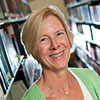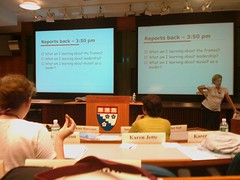This article is more than 5 years old.
The past two days have been filled with in-depth discussion and analysis using the four frames (perspectives) for making leadership choices. As I mentioned in my overview a few days ago, this week is being structured around the framework of Bolman and Deal’s four frame model of organizations (structural, human resources, political and symbolic). After our Sunday afternoon overview of the model, Monday and Tuesday have been filled with studying and discussing various case studies of scenarios where we have been asked to apply each of the four frames to examine the different perspectives you would want to consider when deciding how to handle the situation. Our instructors for the two days have been Joan Gallos, Joe Zolner and Maureen Sullivan.
One of the first things we did was a self assessment to find out what our preferred frame really is. We used a self-rating survey to accomplish this. Most people found that they had one or two strong frames, and then the other two were weak or almost non-existent. As you might expect, the strongest frames were structural (after all, it is a group of librarians) and human resources. The other two frames, political and symbolic, were very under represented. As one moves up the leadership ladder, these two frames become the more important ones to master.
To help visualize the types of issues that might be focuses of the different frames, here are some concepts that the instructors highlighted:
Structural: rules, regulations, goals, policies, roles, tasks, job descriptions, chain of command, assessment and reward systems, spans of control, formal feedback loops, specialization/division of labor
Human Resource: needs, skills, relationships, perceptions and attitudes, morale, motivation, training and development, interpersonal and group dynamics, teams, job satisfaction, participation and involvement, support, respect for diversity
Political: key stake holders, divergent interests, scarce resources, agendas, bases of power, influence, conflict, competition, coalitions, alliances, networks
Symbolic: culture, ceremonies, stories, myths, symbols, metaphors, vision, charisma, values
The structural leader
- clarifies organizational goals
- develops clear rules and effective procedures
- defines roles and clarifies responsibilities
The human resource leader
- identifies people’s needs
- offers personal support
- recognizes participants’ strength
- provides opportunities for growth
The political leader
- understands distribution of resources
- identifies major constituencies
- builds coalitions
- assesses risks and opportunities
- negotiates differences and reaches compromises
The symbolic leader
- interprets meanings
- articulates vision or purpose
- strengthens norms
- reinforces culture with traditions or rituals
We have been learning that, in every organizational situtation, each of these four frames plays a role. And a good leader will try to examine every situation through each of these four lenses. Instead of settling for the perspective with which we are most comfortable, we can expand our choice of options by “flipping the frame” and looking at the situtation through one of the other lenses.


1 Comment on ‘Leadership Institute: Reframing and Frame Flipping’
Thanks for the post! I hadn’t heard of this survey before and it looks like an interesting way to approach leadership. It parsed out a few things that in other surveys I’ve seen paired up in the same category. I hope the Institute is going well!